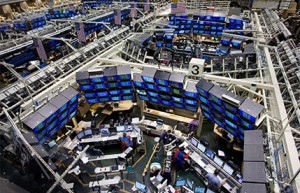 The Boy who Cried Wolf! How long can the DOW Jones Industrial Index keep pushing into long-term highs?
The Boy who Cried Wolf! How long can the DOW Jones Industrial Index keep pushing into long-term highs?
Global stock markets are rallying like never before, bewildering analysts and leaving investors stuck on the sidelines with the DOW Jones Industrial Index touching a high of 14,476 on the 12th March. This beats the previous long-term high set on the 11th Oct 2007 when the DOW reached 14,194. Before the impact of the GFC (Global Financial Crisis) triggered the second biggest stock market crash in modern history.
Back in October 2007, investors were still mostly unaware of what Subprime mortgage loans were. As analysts, we could see weakness in the Home Construction segment. And defaulting home loans were at extreme highs. None of us knew that this would result in a catastrophic event that would impact on a global level. But then again, if we had any idea. That the problem of Collateralized Debt Obligations (CDO’s). Was so deeply ingrain into the financial system. We would have run to the hills long before 2008.
This week’s new all time high for the DOW Jones Industrial Index is during a very different economic environment. Economic growth is substantially slower (2.2% GDP at the end of 2007 compared to 1.6% GDP at the end of 2012); Unemployment is substantially higher (4.7% end of 2007 compared to 7.7% March 2013 – peaking at 10% in Nov 2009); and Retail Spending has barely improved since the GFC (peaking at 5.2% at the end of 2007 and dropping to 4.6% in March 2013). See the below images.
As “Fear of Missing Out” drive Mum and Dad investors to start pondering buying of stocks. Headlines are now starting to appear in the newswires questioning the validity of these new long-term highs.
In February, we saw a market pullback that was on the heels of what is referred to as Sequestration – the automatic budget cuts that will wipe $85 billion from the US governments’ budget. In December, we had a sizeable pullback on the DOW Jones Industrial Index of approximately 500 points (3.8%). As fears of raising the debt ceiling and again the budget balance, sent investors into a panic. In fact, we have seen the US markets capitulate several times in the last 12-months as the newswires tout “Doom & Gloom” over the federal budget balance and sovereign debt ceiling.
So how can the DOW Jones Industrial Average be making all time highs despite a weaker economic environment?
The stock market is a leading indicator of the economy. By roughly six months. Economic data will show a change when it occurs with GDP a lagging indicator to Retail Sales and Unemployment. What this means is that investors are buying up stocks in anticipation of improving economic conditions later in 2013.
The International Monetary Fund (IMF) produces the World Economic Outlook each year. Their projection for 2013 is for global growth as “the factors underlying soft global activity (from 2012) are expected to subside. However, this upturn is expected to be more gradual than in the October 2012 World Economic Outlook projections.”
So there’s hope out there, and this is driving the DOW Jones Industrial Average higher. That’s not to say that we won’t see a market pullback. Possibly heading into May/June. The strength of the US recovery is by no means solid, and a GDP annual growth rate of 1.6% is barely enough to sustain the world’s largest economy when you consider Inflation.
Also, consider the ongoing sovereign debt issues in Europe and a weaker Asian region. And there’s no wonder that the newswires have plenty of fodder to write about.
For me, the defining factor is the trend. The DOW Jones Industrial Average (at time of writing) is maintaining a solid medium-term upwards trend. I would suggest it might be a little overbought at the moment, with the charts showing slower buyer momentum in the last few sessions. But that is by no means a clear indication that this trend has come to an end just yet.
The more the newswires keep touting an end to the Bull market. The less sensitive readers will become to the real warning signals. Just like the little boy who cried wolf. Investors are becoming complacent and after experiencing a 2000 point rise, or 16%, on the DOW Jones Industrial Average since the low in November. No longer consider that there might be a wolf sitting in the treeline on the edge of the forest.
Action can take, but the patient investor will wait to identify a signal first. The probability that the markets would fall thousands of points in one day is quite low (although not impossible), so there should be plenty of time to act if the trend changes. And when that does occur, we’ll be ready for that wolf with strategies to protect and profit from a falling market.



